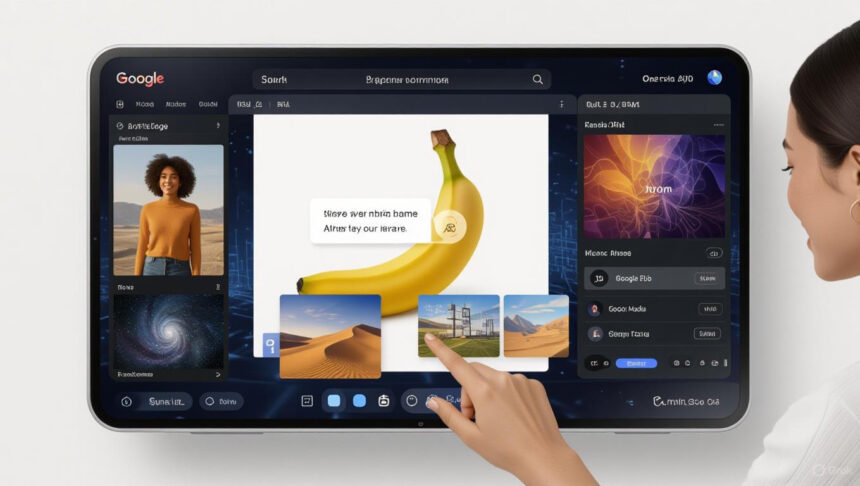Google’s latest AI breakthrough, Gemini 2.5 Flash Image—affectionately nicknamed “Nano Banana”—has taken the creative world by storm since its debut on August 26, 2025. This cutting-edge image editing and generation tool, developed by Google DeepMind, is redefining how we manipulate visuals, earning top marks in benchmarks like LM Arena for its unparalleled precision and ease of use. Whether you’re a casual user tweaking selfies or a professional designer crafting complex visuals, Nano Banana makes advanced image editing accessible to all, sparking excitement and a flurry of memes across platforms like Reddit.
Nano Banana builds on the multimodal strengths of the Gemini 2.5 Flash model, focusing specifically on image creation and editing. Unlike earlier AI tools that struggled to maintain consistent details—like a person’s facial features or a pet’s unique traits—Nano Banana excels at preserving character likeness across multiple edits. This means you can transform a photo of yourself into a 1920s flapper or a futuristic astronaut, and the AI ensures you still look like you. This consistency is a game-changer for storytelling, letting users craft cohesive visual narratives across different settings or eras.
The tool’s magic lies in its text-prompt-driven interface. Simply upload an image and describe your desired changes in plain language—like “swap my jacket for a leather trench coat” or “add a sunset behind my dog.” Nano Banana interprets these instructions with remarkable accuracy, delivering photorealistic results. It also supports multi-step editing, so you can refine an image iteratively: start by changing a room’s wall color, then add furniture, and finally tweak the lighting. Another standout feature is image blending, which lets users merge photos creatively—think combining a portrait with a starry sky or fusing a person and their pet into a playful scene.
Beyond casual use, Nano Banana offers powerful tools for professionals. Its style transfer feature can apply patterns from one image—like a floral design—to another, such as a piece of clothing. For developers, the model is accessible via the Gemini API, Google AI Studio, and Vertex AI, making it easy to integrate into apps or workflows. At $0.039 per image (equivalent to 1290 output tokens), it’s cost-effective, with platforms like OpenRouter.ai and fal.ai bringing it to millions of developers worldwide. Google also embeds SynthID watermarks in all outputs, ensuring transparency in AI-generated content amid growing concerns about authenticity.
Getting started is simple. Users can jump in via the Gemini app (gemini.google.com) or experiment in Google AI Studio, which offers demos like “Past Forward” for testing character consistency or “Pixshop” for intuitive photo editing. Social media feedback has been glowing, with users on X and Reddit calling it a “Photoshop rival” for its ability to handle complex edits that once required hours of manual work. YouTube creators have showcased its versatility, from crafting AI influencers to streamlining film production visuals. Still, it’s not perfect—rendering long text or maintaining factual accuracy in intricate scenes remains a work in progress.
Nano Banana’s impact reaches far beyond hobbyists. In creative industries, it could transform workflows for graphic designers, marketers, and filmmakers, potentially reducing reliance on costly software. In education, its natural language interface empowers non-experts, including those with disabilities, to create polished visuals from rough sketches. E-commerce businesses might use it to generate product variations instantly, while educators could craft interactive diagrams for lessons.
However, its rise raises questions. Could tools like Nano Banana disrupt jobs in photography or illustration? As AI blurs the line between human and machine creativity, debates about authenticity and intellectual property are inevitable. Google is already planning upgrades, focusing on improving multi-image blending and text rendering as the tool moves out of preview mode.
Nano Banana is more than a quirky AI—it’s a glimpse into the future of creativity. By combining intuitive controls with powerful capabilities, it empowers anyone to turn ideas into stunning visuals. Whether you’re enhancing everyday photos or pushing the boundaries of design, Nano Banana is poised to become a staple in the digital toolbox, proving that AI can be both fun and transformative.
Nano Banana: Google’s Revolutionary AI Image Editor
Nano Banana: Google's Revolutionary AI Image Editor

I am a Software Engineer and the Founder of mcaEducation4all.
Leave a comment

